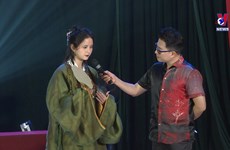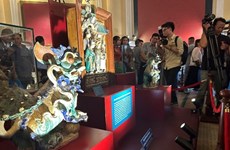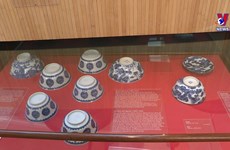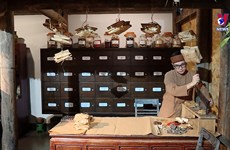Traditional singing rings out in Old Quarter
The audience of about 20 sit in rapt silence, their eyes glued to the
female soloist. The strains of traditional ca tru (chamber) music
reverberate around the dimly lit prayer hall in Quan De Temple. Only the
stage is illuminated, which at the beginning of the performance is
separated from the audience by a bamboo curtain. After the first song,
the curtain is raised.
The audience of about 20 sit in rapt silence, their eyes glued to the
female soloist. The strains of traditional ca tru (chamber) music
reverberate around the dimly lit prayer hall in Quan De Temple. Only the
stage is illuminated, which at the beginning of the performance is
separated from the audience by a bamboo curtain. After the first song,
the curtain is raised.
"This highly refined music does not reveal its secrets immediately, but grows on you, taking one gradually into a different world, away from the hustle and bustle (and inescapable vehicular horns) of Old Quarter traffic," wrote Chang Tou Liang from Singapore.
"It is a magical feeling that is difficult to describe, one that goes beyond the superficiality and surface glitz of many more popular art forms (the water puppets come to mind here)," he added.
Traditional chamber music is performed every Sept. 24 night in the temple on Hang Buom street . They do not use microphones, and the audience is usually dominated by foreigners, who pays 10 USD each for a ticket.
"The secret to attracting tourists to the sounds is the light," said singer Pham Thi Hue. "If we lit the whole room, the audience would immediately be distracted from the performers and the instruments."
Some tourists complain that it is too dark to take photos but most of them understand that the dimly lit room helps one to focus on the singing and the music, Hue said.
The fact that we don't use microphones or a speaker system means they have to concentrate that much harder on the melodies and the words, she added.
The show lasts just an hour, during which the artists also explain to the audience in Vietnamese and English the meaning of the music and the names of the instruments.
"I have a lot of questions on the content of the songs," said Joachim Nguyen, an overseas Vietnamese from France . "Though I can speak Vietnamese, I cannot understand all the songs as they often use a strange type of Vietnamese."
While listening to the artists' explanation of the music, members of the audience are invited to drink Vietnamese green tea and eat sweetened bean cakes.
In addition to the Sept. 24 performance at Quan De Temple, the musicians also perform at an ancient house at 87 Ma May street.
Musicians from the Hanoi Chamber Music Club at Kim Ngan Temple on Hang Bac street also perform every Sunday.
Nguyen Thu Thuy, an official from the Hanoi Old Quarter Management Board, said linking traditional arts with tourism had proved very popular with visitors.
"Though the shows in the Old Quarter have been run for more than a year, most of our guests are independent travellers not members of a tour group," Hue said. "We have signed contracts with some tourism companies, including the Vietnam Tourism and Hanoi Tourism companies. Yet the number of guests taking package tours coming to our shows is still limited."
Travel agents are not particularly interested in ca tru compared with say water puppetry, she said. Maybe because the language is far more important than the music in ca tru, and many people can't understand the worlds.
Thuy said she planned to promote the art form in the local media and hold some more cultural activities in the Old Quarter.
In addition to the performances in the Old Quarter, ca tru fans can also attend shows every Sept. 24 night and in the morning of the last Sunday of each month at Bich Cau Dao Quan, 14 Cat Linh street , and between 9am and 10am on the first Sunday of each month at the Museum of Ethnology , Nguyen Van Huyen street . /.
"This highly refined music does not reveal its secrets immediately, but grows on you, taking one gradually into a different world, away from the hustle and bustle (and inescapable vehicular horns) of Old Quarter traffic," wrote Chang Tou Liang from Singapore.
"It is a magical feeling that is difficult to describe, one that goes beyond the superficiality and surface glitz of many more popular art forms (the water puppets come to mind here)," he added.
Traditional chamber music is performed every Sept. 24 night in the temple on Hang Buom street . They do not use microphones, and the audience is usually dominated by foreigners, who pays 10 USD each for a ticket.
"The secret to attracting tourists to the sounds is the light," said singer Pham Thi Hue. "If we lit the whole room, the audience would immediately be distracted from the performers and the instruments."
Some tourists complain that it is too dark to take photos but most of them understand that the dimly lit room helps one to focus on the singing and the music, Hue said.
The fact that we don't use microphones or a speaker system means they have to concentrate that much harder on the melodies and the words, she added.
The show lasts just an hour, during which the artists also explain to the audience in Vietnamese and English the meaning of the music and the names of the instruments.
"I have a lot of questions on the content of the songs," said Joachim Nguyen, an overseas Vietnamese from France . "Though I can speak Vietnamese, I cannot understand all the songs as they often use a strange type of Vietnamese."
While listening to the artists' explanation of the music, members of the audience are invited to drink Vietnamese green tea and eat sweetened bean cakes.
In addition to the Sept. 24 performance at Quan De Temple, the musicians also perform at an ancient house at 87 Ma May street.
Musicians from the Hanoi Chamber Music Club at Kim Ngan Temple on Hang Bac street also perform every Sunday.
Nguyen Thu Thuy, an official from the Hanoi Old Quarter Management Board, said linking traditional arts with tourism had proved very popular with visitors.
"Though the shows in the Old Quarter have been run for more than a year, most of our guests are independent travellers not members of a tour group," Hue said. "We have signed contracts with some tourism companies, including the Vietnam Tourism and Hanoi Tourism companies. Yet the number of guests taking package tours coming to our shows is still limited."
Travel agents are not particularly interested in ca tru compared with say water puppetry, she said. Maybe because the language is far more important than the music in ca tru, and many people can't understand the worlds.
Thuy said she planned to promote the art form in the local media and hold some more cultural activities in the Old Quarter.
In addition to the performances in the Old Quarter, ca tru fans can also attend shows every Sept. 24 night and in the morning of the last Sunday of each month at Bich Cau Dao Quan, 14 Cat Linh street , and between 9am and 10am on the first Sunday of each month at the Museum of Ethnology , Nguyen Van Huyen street . /.













